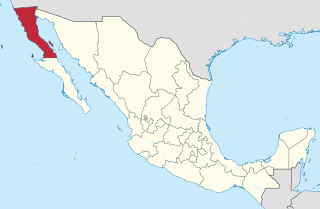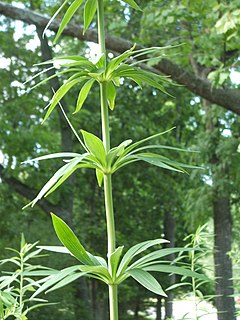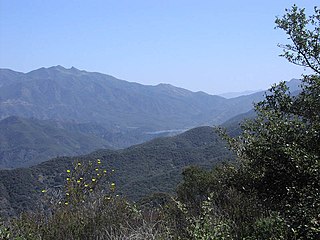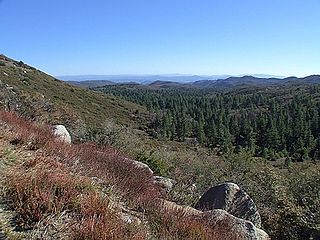
Lupinus arboreus, common name yellow bush lupine (US) or tree lupin (UK), is a species of flowering plant in the legume family Fabaceae.
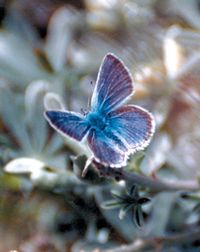
The Mission blue is a blue or lycaenid butterfly subspecies native to the San Francisco Bay Area of the United States. The butterfly has been declared as endangered by the US federal government. It is a subspecies of Boisduval's blue.

Lupinus bicolor is a species of lupine known as the miniature lupine, Lindley's annual lupine, pigmy-leaved lupine, or bicolor lupine.

Lupinus albifrons, silver lupine, white-leaf bush lupine, or evergreen lupine, is a species of lupine (lupin). It is native to California and Oregon, where it grows along the coast and in dry and open meadows, prairies and forest clearings. It is a member of several plant communities, including coastal sage scrub, chaparral, northern coastal scrub, foothill woodland, and yellow pine forest.
Lupinus adsurgens is a species of lupine known by the common name Drew's silky lupine. It is native to the Sierra Nevada and coastal mountain ranges of northern California and southern Oregon, where it grows in forest and other mountain habitat. It is a perennial herb growing 20–60 centimetres (7.9–23.6 in) in height. Each palmate leaf is made up of 6 to 9 leaflets each up to 5 centimetres (2.0 in) long. The herbage is hairy and silvery or gray-green in color. The inflorescence is up to 23 centimetres (9.1 in) long, bearing flowers just over a centimeter long. The flower is pale pink or purple to yellowish with a white or yellow patch on the banner. The fruit is a silky-haired legume pod 2 to 4 centimetres (1.6 in) long containing 3 to 6 seeds.
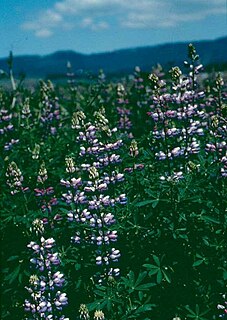
Lupinus albicaulis is a species of lupine known by the common name sicklekeel lupine. It is native to the western United States from Washington to California, where it grows mostly in mountain habitat. It is a hairy, erect perennial herb often exceeding a meter in height. Each palmate leaf is made up of 5 to 10 leaflets each up to 7 centimetres long. The inflorescence is up to 44 centimetres (17 in) long, bearing whorls of flowers each 1 to 1.6 centimetres long. The flower is purple to yellowish or whitish in color and has a sickle-shaped keel. The fruit is a silky-hairy legume pod up to 5 centimetres (2 in) long containing several seeds. In Oregon, where the plant is native, it has been cultivated for several uses, including reforestation and revegetation of roadsides and other disturbed habitat.
Lupinus antoninus is a rare species of lupine known by the common name Anthony Peak lupine. It is endemic to northern California, where it is known from only four occurrences in the North Coast Ranges, including near Anthony Peak.
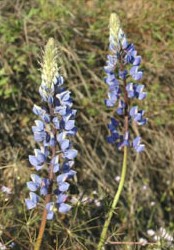
Lupinus benthamii is a species of lupine known by the common name spider lupine.
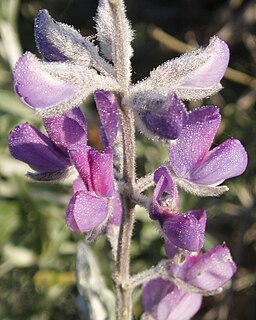
Lupinus chamissonis is a species of lupine known by the common name Chamisso bush lupine. It is endemic to California, where it is known from most of the length of the coastline. It grows in sand dunes and other immediate coastal habitat.
Lupinus citrinus is a species of lupine known by the common names orange lupine, orangeflower lupine, and fragrant lupine. It is endemic to California, where it is known from a section of the Sierra Nevada foothills extending from Mariposa to Fresno Counties. This is an annual herb growing 10–60 centimetres (3.9–23.6 in) tall. Each palmate leaf is made up of 6 to 9 leaflets up to 3.5 centimetres (1.4 in) long. The herbage is coated in tiny white hairs. The inflorescence bears several flowers, sometimes in whorls. Each flower is roughly a centimeter long and orange to yellow to white in color. The fruit is a legume pod 1 or 2 centimetres (0.79 in) long containing seeds which resemble "pieces of granite."
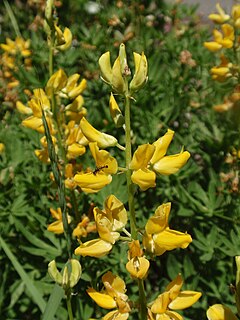
Lupinus croceus is a species of lupine known by the common name saffron-flowered lupine. It is endemic to the northernmost mountains of California, including the Klamath Mountains, where it grows in generally dry, rocky habitat. This is an erect perennial herb growing 40–60 centimetres (16–24 in) tall. The hairy palmate leaves are made up of 5 to 9 leaflets each up to 6 centimetres (2.4 in) long. The inflorescence is a raceme of many flowers, sometimes arranged in whorls. Each flower is just over a centimeter long and bright yellow to orange in color. The fruit is a hairy legume pod up to 3.5 centimetres (1.4 in) long.

Lupinus flavoculatus is a species of lupine known by the common name yelloweyes, or yellow-eyed lupine.,
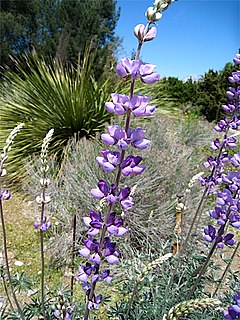
Lupinus longifolius is a species of lupine known by the common name longleaf bush lupine.
Lupinus luteolus is a species of lupine known by the common names pale yellow lupine and butter lupine. It is native to the coastal mountain ranges of Oregon and California as far south as the Transverse Ranges, where it grows in open habitat such as clearings and sometimes disturbed areas. It is an annual herb with a rigid stem growing to maximum heights anywhere between 30 centimeters and 1.5 meters, and known to exceed that at times. Each palmate leaf is made up of 7 to 9 hairy leaflets 1 to 3 centimeters long. The inflorescence is a raceme of crowded whorls of flowers each just over a centimeter long. The flower is often pale to bright yellow, but can be blue or pinkish. The fruit is a hairy, rounded or oval legume pod generally containing 2 seeds.
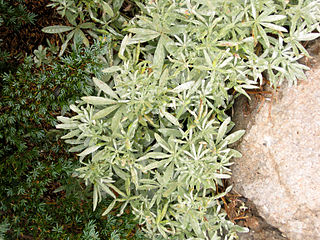
Lupinus obtusilobus is a species of lupine known by the common name bluntlobe lupine. It is native to high mountains of northern California, including the North Coast Ranges, the Klamath Mountains, and the northernmost Sierra Nevada. It grows in various types of mountain habitat, sometimes carpeting meadows with its purple blooms in the spring. It is a perennial herb growing erect or decumbent along the ground, its stem 15–30 centimetres (5.9–11.8 in) long. Each palmate leaf is made up of 6 to 7 leaflets up to 5 centimetres (2.0 in) long. The herbage is coated in silvery silky hairs. The inflorescence is a small raceme with a few whorls of flowers each just over a centimeter long. The flower is blue to purple with a yellowish patch on its banner. The fruit is a silky-haired legume pod up to 4 centimetres (1.6 in) long.

Lupinus rivularis is a species of lupine known by the common name riverbank lupine. It is native to western North America from southern British Columbia to northern California, where it is known mainly from coastal habitat in such places as both Olympic and Redwood National Parks, and at Point Reyes National Seashore. This is a robust, erect perennial herb or subshrub growing up to about a meter tall. The mostly hairless stem is thick, hollow, and reddish in color. Each palmate leaf is made up of 5 to 9 wide leaflets 2–4 centimetres (0.79–1.57 in)s long. The inflorescence is a raceme of many flowers sometimes arranged in whorls. The flower is light purple in color, often with white parts or shading. The fruit is a somewhat hairy legume pod up to 7 centimetres (2.8 in) long which turns dark as it ages.

Lupinus sericatus is a species of lupine known by the common name Cobb Mountain lupine. It is endemic to the North Coast Ranges of California north of the San Francisco Bay Area, where it grows in the forest, woodlands, and chaparral of the slopes and canyons. It easily colonizes disturbed habitat as well. This is a perennial herb growing up to half a meter tall. Each palmate leaf is made up of 4 to 7 distinctive wide spoon-shaped leaflets each 3 to 5 centimeters long. The inflorescence is a raceme of several whorls of purple flowers, each flower between 1 and 2 centimeters long. The fruit is a hairy legume pod 2 or 3 centimeters long.

Lupinus stiversii is a species of lupine known by the common names harlequin annual lupine and harlequin lupine. The plant was named for Army physician Dr. Charles Austin Stivers, who first collected it in 1862 near Yosemite.

Lupinus truncatus is a species of lupine known by the common name collared annual lupine.

Lupinus sericeus is a species of flowering plant in the legume family known by the common name silky lupine or Pursh's silky lupine. It is native to western North America from British Columbia to Arizona and east to Alberta and Colorado.


